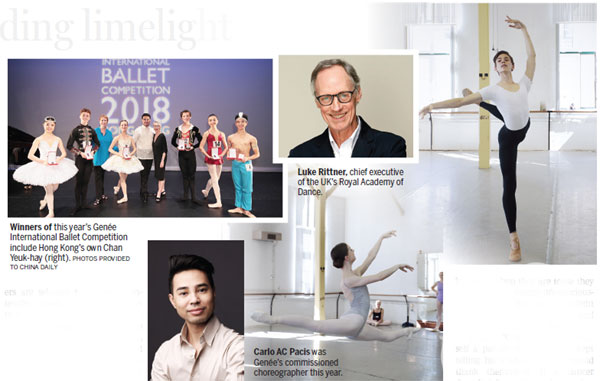Finding limelight
Updated: 2018-08-17 07:02
By Wang Yuke in Hong Kong(HK Edition)
|
|||||||||
Six young ballet talents scooped up the coveted medals in the prestigious Gene International Ballet Competition 2018, which ended on Aug 12 at Hong Kong City Hall. Among the awardees were a dancer from Hong Kong, two from Australia and one each from Japan, New Zealand and the United Kingdom.
Jordan Chan Yeuk-hay, 16, the only Hong Kong candidate to make the finals, won the bronze medal and the Margot Fonteyn Audience Choice Award. Chan, who started learning ballet when he was 3 and trained under Yui Man-cheung at the city's Jean M. Wong School of Ballet, said after the finalists were announced, "I'm honored to represent Hong Kong competing for world-level glory and proud to get to the final round on behalf of Hong Kong."
Chan revealed the greatest lesson he learned from this year's commissioned choreographer and coach Carlo AC Pacis was "talk to the audience with your eyes."
Gene is open to dancers aged 15 to 19 from around the world who have attained the required certificates granted by the UK's Royal Academy of Dance. Fifty one dancers are selected to attend an intensive five-day coaching sessions to perfect three different routines - classical ballet variations, the dancer's own chosen piece and a world premiere, a piece designed by the year's commissioned choreographer - before competing for the sought-after medals.
Hong Kong was an apt choice as the host city for the competition this year, said Luke Rittner, chief executive of the Royal Academy of Dance. "The city is recognized as an important center of the world's culture and arts, incorporating international influences."
Today a dance competition is no longer about just winning and losing; it presents an opportunity for dancers around the world to learn in the same classroom. It's a platform for them to give and take, said Joanne Michel, one of the judges.
Dancers were coached in a spacious mirror-lined dance room, rehearsing their routines for three days leading to the semi-final under the gaze of coach Pacis.
They had begun showing signs of nervousness in the lead-up to the big day. "When they are tense they exert excessive energy unconsciously, resulting in rigid steps and tight movement, with no fluidity and breath in it," Pacis explained.
"Relax", "Commit", "Give yourself a pat on the back" he kept telling his students. "They should thank themselves. If a dancer doesn't take pride in his or her own work, there's no point for the audience trying to appreciate their performance. There's a standard for perfection, but no one is perfect. We should accept that."
The solo routine for female dancers choreographed by Pacis is about the journey of young ballerinas toward adulthood and becoming full-fledged artists. The dancer is imagined as a bud yet to bloom. Hit by a summer storm, she sways in panic and terror, unsure of her ability to survive. When everything is back to normal, she realizes, "hey, I'm standing here, I'm stronger than I expected," Pacis explained. It's a metaphor for a rite of passage, during which a young woman braves setbacks and is forced to become stronger in the end.
"It's important for dancers to learn variations from each other and to work with different choreographers," said Michel.
Learning dance is a life-long pursuit, even after a student has become a professional dancer. "It takes incredible self-discipline; they have to be fully dedicated, which requires guts, bravery and determination," Rittner remarked. What is unique to ballet art, he adds, is that "as a dancer you need to understand your body, be aware of it. You cannot do it in a half-hearted way".
Like any other art form, dance is changing all the time, Michel said. She is very positive that young dancers will breathe new life into the scene as "young dancers are particularly open to change and very adaptive".
jenny@chinadailyhk.com

(HK Edition 08/17/2018 page14)